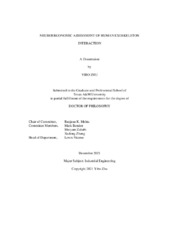| dc.description.abstract | Industrial passive low-back exoskeletons are novel interventions that aim to reduce physical risks by reducing/redistributing spine biomechanical loads. However, exoskeletons may impose newer risks, such as high cognitive processing demand requirements and longer task adaptation needs, that may impact worker safety, but these have been relatively unexplored. A key barrier is that current cognitive fit assessments of human exoskeleton interactions are generally subjective and/or intrusive (e.g., dual-task paradigm). A neuroergonomic approach may afford more in-depth and continuous assessment of human exoskeleton interactions.
In order to reliably monitor neurocognitive processes associated with human exoskeleton interaction, functional and technological requirements of various neuroergonomic techniques were compared by conducting a comprehensive systematic review. Functional Near-Infrared Spectroscopy was identified as the optimal neuroergonomic assessment tool for evaluating human exoskeleton interactions during simulated manual handling tasks, owing to its ambulatory and high spatial resolution capabilities. In addition, methodological recommendations on device selection, neural signal calibration strategy, data collection and processing methods, as well as results representation format were developed for future ambulatory human exoskeleton (and machine) interaction studies.
Based on the guidance synthesized in the review article, neural signatures of human exoskeleton interaction were investigated in a simulated manual handling study with a passive low-back exoskeleton. The recommended functional and effective connectivity analyses revealed that the tested exoskeleton imposed greater cognitive processing demands, which were further clarified with a cognitive dual-task paradigm, and thus these challenges were concluded to marginalize any biomechanical benefits.
Finally, a composite neuroergonomic metric, namely neural efficiency, was developed from biomechanical and neural activation measures to capture short-term human exoskeleton adaptation during simulated manual handling tasks. Neural efficiencies of the frontal and premotor cortices, regions implicated in motor adaptation, indicated that exoskeleton-based manual handling tasks were less efficient and resulted in longer motor-task adaptation processes than the control task. Through this investigation, the utility of neural efficiency metric was expanded to ambulatory work evaluations requiring human-machine interactions.
Based on the aforementioned findings, this dissertation research highlights strong potential of Functional Near-Infrared Spectroscopy to assess human exoskeleton interactions in ambulatory settings. The proposed neuroergonomic analytical framework can: 1) fundamentally advance our knowledge of how exoskeletons impact neurocognitive processing, which in turn can inform hardware development of more fluent human exoskeleton interaction, and 2) enable tracking of human exoskeleton interactions in real-time, which is expected to contribute to the development of adaptive control algorithms for next generation active exoskeletons. | |


